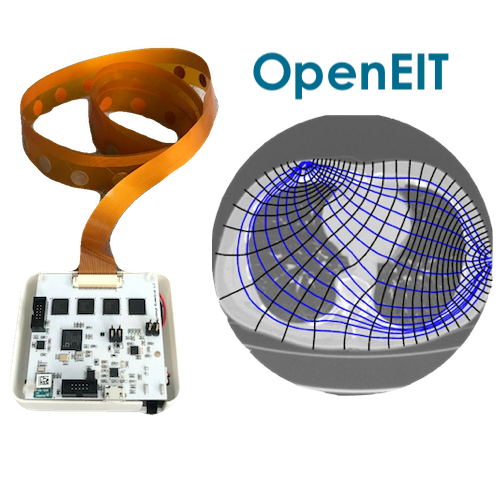Application
Affordable imaging based on the electrical properties of tissues.
Contributors
5+ contributors¹
Progress
Hardware: Beta, CC BY-NC-SA 4.0 License.
Software: Beta, CC BY-NC-SA 4.0 License.
Affordable imaging based on the electrical properties of tissues.
OpenEIT is an open source and safe way to experiment with biomedical imaging. The device is composed of reconstruction algorithms, a PCB and can re-create an image in real time. To accelerate the development of this emerging imaging modality, everything from hardware through to software is offered open source.
The device works by creating an AC current through the conductive medium to be interrogated, and by measuring the impedance magnitude and phase. This process is repeated around every combination of an array of electrodes, which gives the base data to perform a tomographic reconstruction. The device autocalibrates based on a resistor on the board, which also adjusts for environmental temperature differences.
The software is user friendly, giving image reconstruction functionality with 8, 16 and 32 electrode combinations, as well as bioimpedance spectroscopy and time series modes of operation.
Applications:
Image Reconstruction:
It allows tracking the changes in the lungs or other body parts over time. It can be employed to do gestural recognition based on arm muscle movements. It can also be used on small volumes to determine the presence of different types of cells, e.g., hemoglobin in a blood sample or other cell metrics.
Material Identification:
Multifrequency EIT can generate a spectrum to identify tissues such as fat, tumors, muscle, bone, or areas of higher blood flow.
Time Series Measurement:
With time series measurement one can measure the expansion and contraction of the lungs, blood flow change through the valves of your heart (impedance cardiography), stomach fullness or bladder changes.
Specifications:
- 32 electrodes.
- Bluetooth.
- Accelerometer.
- 160 kSPS sample rate for impedance measurements.
- 16-bit resolution bio-impedance spectroscopy with differential referencing.
- PCB is a tiny and portable 2” square.
- Open source software comes with three different types of tomographic reconstructions: GREIT, Gauss-Newton Method, and Back Projection.
- Time series impedance measurements, bio-impedance spectroscopy, as well as electrical impedance tomography can be done in the 80Hz-80 kHz range with up to 32 electrodes.
- DC removal filters to meet IEC60601-1 safety specifications.
- Comes with cylindrical tank and flexible electrode cable for testing.
Affiliations
1Mindseye Biomedical


